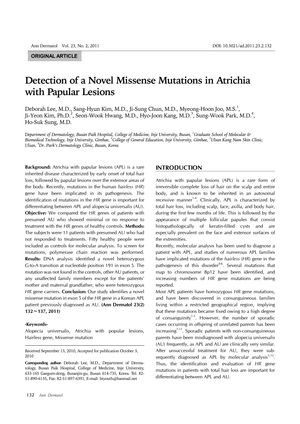TLDR Researchers found a new mutation in the HR gene linked to a rare hair loss condition.
In 2011, researchers discovered a novel missense mutation in the hairless (HR) gene in a Korean patient with Atrichia with Papular Lesions (APL), a condition causing early total hair loss and papular lesions. The study included 11 patients with presumed Alopecia Universalis (AU) who were unresponsive to treatment, and 50 healthy controls. The mutation, a G-to-A transition at nucleotide position 191 in exon 5 of the HR gene, resulted in a glycine to glutamate substitution (G64E) and was absent in the controls, other AU patients, and unaffected family members, except for the patient's mother and maternal grandfather who were heterozygous carriers. The study also noted a new clinical sign of APL, which are follicular hypopigmented macules, and suggested that isolated cases of APL might be more common than previously thought. It recommended HR gene testing for children with presumed AU who do not respond to standard treatments. The study highlighted the need for comprehensive HR gene sequencing for accurate APL diagnosis and suggested three possible explanations for the proband's homozygosity: non-paternity, a large heterozygous deletion in the father, or a spontaneous mutation.
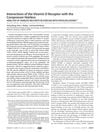 42 citations
,
July 2007 in “Journal of Biological Chemistry”
42 citations
,
July 2007 in “Journal of Biological Chemistry” Most Hairless gene mutations reduce its ability to work with the Vitamin D Receptor, which might explain a certain type of hair loss.
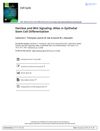 74 citations
,
September 2006 in “Cell Cycle”
74 citations
,
September 2006 in “Cell Cycle” The HR protein's role as a repressor is essential for controlling hair growth.
 19 citations
,
May 2006 in “Clinical and Experimental Dermatology”
19 citations
,
May 2006 in “Clinical and Experimental Dermatology” Researchers found a new mutation causing total hair loss from birth.
23 citations
,
July 2003 in “Journal of Investigative Dermatology” Genetic testing for hairless gene mutations is crucial to correctly diagnose and treat atrichia with papular lesions.
69 citations
,
May 2002 in “Journal of Investigative Dermatology” Congenital atrichia with papular lesions is often misdiagnosed, and new diagnostic criteria can improve accuracy.
949 citations
,
January 2001 in “Cell” Adult mouse skin contains stem cells that can create new hair, skin, and oil glands.
88 citations
,
June 2000 in “Journal of Investigative Dermatology” 66 citations
,
December 1999 in “Journal of Investigative Dermatology” New mutations in the hairless gene may cause hair loss and affect bone development.
126 citations
,
October 1998 in “Experimental Dermatology” The hr gene is crucial for skin and hair health, with mutations causing hair disorders.
86 citations
,
June 1998 in “Journal of Investigative Dermatology” The hairless gene mutation causes baldness by disrupting hair follicle structure.
412 citations
,
January 1998 in “Science” A mutation in the human hairless gene causes alopecia universalis.
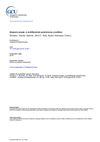 148 citations
,
December 2018 in “Journal of autoimmunity”
148 citations
,
December 2018 in “Journal of autoimmunity” Alopecia areata is an autoimmune disease causing patchy hair loss, often with other autoimmune disorders, but its exact causes are unknown.
May 2018 in “Journal of cosmetology & trichology” Combining platelet-rich plasma therapy with prostaglandin-F eye drops can significantly regrow hair in alopecia universalis.
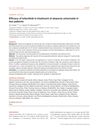 51 citations
,
June 2016 in “Journal of the European Academy of Dermatology and Venereology”
51 citations
,
June 2016 in “Journal of the European Academy of Dermatology and Venereology” Tofacitinib was effective in treating hair loss in two patients with alopecia universalis.
